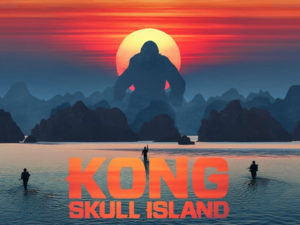
Fact: Seeing King Kong duke it out with other cryptids is fun. Like, really fun (and that’s coming from a pretentious film snob whose favorite films are arthouse dramas my mom falls asleep to). But as fun as the action sequences in “Kong: Skull Island” may be, the film is ultimately another unnecessary, uninspired big-budget franchise film that substitutes substance for schlock.
Legendary Pictures spawned a cinematic franchise following the success of director Gareth Edwards’ 2014 film, “Godzilla,” which itself was a reboot of the beloved Toho franchise. The MonsterVerse (not to be confused with the Universal Monsters cinematic universe, because unoriginality is in vogue) purportedly aims to capture the King of Monsters squaring off with Kong in a computer generated imagery (CGI) fest in 2020 but not without a series of films like “Skull Island” to establish some worldbuilding.
Truth be told, there is no protagonist in “Skull Island.” There are a handful of characters that, for lack of better descriptions, try not to die. But that’s about it. It’s a shame that so many talented actors are put to waste: Samuel L. Jackson is a one-dimensional Captain Ahab parallel, Brie Larson is an anti-war photographer who, along with Tom Hiddleston’s hunter-tracker character, sympathizes with the still-developing Kong. To be fair, John C. Reilly’s role as a stranded World War II pilot trapped on Skull Island since 1943 provides some amusing comic relief but like the rest of the cast, his talent is shadowed by a sophomoric script and much more intriguing environment. Why Legendary decided to cast (and underuse) so many accomplished performers on a project with an established fan base such as King Kong is stupefying, however the silver lining takes shape in “Skull Island’s” wealth of monsters and landscapes.
Like “Godzilla,” “Skull Island” paints its titular beast magnificently. There is something so innately satisfying in seeing a colossal ape swat helicopters like flies against a radiant sunset. Beautifully shot, “Skull Island” has no problem framing Kong in full view as he clobbers the mythical inhabitants of Skull Island, often pushing the camera closer for the moments he stomps and swipes away at the invading humans. In his absence, director Jordan Vogt-Roberts hounds the film’s human characters with an abundance of bloodthirsty cryptids to genuinely thrilling results: Monstrous, often benign creatures reminiscent of phasmatodea, oxen, spider-crab hybrids and scaled-down avians akin to pterodactyls are among the many imaginative beasts that inhabit Skull Island. Skullcrawlers, reptilian brutes inspired by the Pokemon Cubone, serve as Kong’s primary antagonists not unlike the role assumed by the MUTO in Edwards’ “Godzilla.” Here and there, the computer-generated backgrounds draw out from the verisimilitude that defines a good majority of the film, but they never overstay their welcome enough to underscore the larger-than-life scenes of kaiju fun. If there is any reason to watch “Skull Island,” it’s the sheer scale of its environment and its CGI monstrosities that a monster movie should proudly flaunt.
In a semi-refreshing manner, “Skull Island” avoids being a carbon copy of the original source material and instead finds itself taking place at the end of the Vietnam War. Keystone 70s rock like that found in Francis Ford Coppola’s “Apocalypse Now” and Oliver Stone’s “Platoon” saturate the film’s soundscape to mixed results, but Henry Jackman’s score overshadows the cliched Vietnam-era soundtrack; I love Sabbath but that love didn’t prevent me from rolling my eyes when “Paranoid” rolled through.
Don’t expect anything more from a 2017 film about King Kong than a stupid (really, really stupid) but exhilarating ride and CGI monsters galore. “Skull Island” fancies itself an anti-war, pro-environmentalist picture, but its bare-bones plot does little more than set the stage for otherworldly behemoths to wreck havoc.








